Spooky spiders: silk, sex and squirting venom
We're wandering into the weird world of spiders! We’ll be looking at spiders that can fly using little silk parachutes and the grisly and gruesome mating habits of black widow spiders. Plus in the news, as UK cases surge, should Covid precautions move to Plan B; how does raw sewage affect our waterways and is your mobile phone damaging your finger?
In this episode
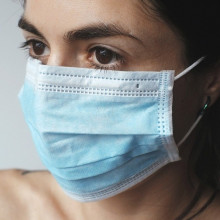
01:03 - To Plan B, or not to Plan B?
To Plan B, or not to Plan B?
Kit Yates, University of Bath; Paul Hunter, University of East Anglia
To Plan B, or not to Plan B; as Covid-19 cases hit a new high recently, that is the question that’s hogged the headlines this week, such as this clip from BBC Radio 4:
Labour has made a stinging attack on the government's COVID strategy and suggested that Sajid Javid is the most complacent health secretary in the history of the NHS. Speaking in the Commons, the Shadow Health Secretary, Jonathan Ashworth, highlighted the pressures facing the health service as infection rates rise and said the vaccination program was stalling. The doctors' union, the BMA, has accused ministers of being willfully negligent by not introducing some coronavirus restrictions in England.
Some, like Bath University mathematician Kit Yates, think that as half term comes to an end, restrictions need to be reintroduced across the board sooner rather than later, as Chris Smith found out...
Kit - I'm worried that when schools do go back that we will see cases rising again and of course that will lead to rises and hospitalisations. Unfortunately that will lead to rises in deaths. At the moment we're averaging a rate of death equivalent to about 50,000 a year, which I think is unacceptably high.
Chris - What would you like to see done as a reaction to the present trends?
Kit - What we could be doing is taking relatively light touch mitigations, things like asking people to wear masks in enclosed public spaces, things like putting mitigations in schools to try to make sure we can mitigate the spread in schools like ventilation and filtering. I think there are small things we can be doing like asking people to work from home, which could all have a big impact on transmission. Cases are not growing that quickly at the moment as the reproduction number is just above one, which means it's growing quite slowly and small things we could do now would help us to bring cases down as we head into winter.
Nevertheless, with R just above 1, meaning the outbreak is growing only very slowly - despite the fact that we’re all out and about - and cases are actually now appearing to fall, others are more sanguine, like UEA Professor of Medicine, Paul Hunter, who favours the status quo, arguing that the answer lies in vaccines and boosters, rather than restrictions; more restrictions, he says, might in fact prolong the pain long term, not lessen it…
Paul - Well, at the moment, it's looking substantially more promising than even a week or so ago. Case numbers have started to decline but we are also beginning to see, I think, hospitalisations now starting to plateau.
Chris - This to my mind, listening to you sounds like you're taking fairly optimistic viewpoint.
Paul - Absolutely. We're in a situation where the vast majority of adults and particularly vulnerable adults have already had one course of vaccine. But, vaccination effectiveness is declining and has continued to decline. On the other hand, recent evidence on the booster vaccine is that it actually is looking substantially more effective at both stopping infections and more importantly, stopping severe disease than many of us were expecting.
Chris - Nevertheless, some people are saying that the current case load translates into tens of thousands of mortalities per year, which some say is unacceptable. How do you read it?
Paul - What we saw last year was a substantial number of excess deaths driven by large numbers of coronavirus deaths. What we're seeing in the last few months is that yes, we are still seeing excess mortality. Only a minority of those excess deaths are in people who have recently tested positive for COVID. It's difficult to know what's driving that. It's plausible that problems around what's called non-pharmaceutical interventions that are actually delaying people getting treatment for heart attacks, or maybe people not actually exercising enough, becoming more sedentary and that's speeding up cardiovascular disease.
Chris - Some people, including letters penned by significant numbers of members of the medical profession (open letters and so on), are calling for the government to put more measures in place to try and head off the surge at the pass as it were. Do you think that's a good idea or do you think actually that we should go steady as she goes, which is apparently the government's present policy? They say they have no plans to escalate things.
Paul - Actually at the moment the indications are that they're going to review this in a week or so's time. And I think that's the right thing to do. You know, nobody can be absolutely certain what's going to be happening but the thing about non-pharmaceutical interventions, like restrictions, is they never prevent infections and we've known this long before COVID.
Chris - When you say 'never protect' you mean they don't ever prevent them but what they do do is kick the can down the road. They're going to happen anyway, they are just going to take longer.
Paul - Absolutely, yes. As Fauci said the other day, people who have been vaccinated will get infected. Even those of us who have been infected will almost certainly get repeat infected. Those of us who've been vaccinated will almost certainly get breakthrough infections and that's because this is a coronavirus. Immunity to infection from coronaviruses are generally quite short-lived. The other coronaviruses typically cause infections every three to six years. What that means is if we implement these restrictions now we might actually suppress the curve a little bit more than it might be otherwise. Ultimately those people still have to have their infection if they've not been boosted. So these restrictions don't ultimately prevent transmission, they just delay it. Sometimes delaying it is all you need. Once we have a vaccine, as we do at the moment, delaying it, paradoxically, could make things worse. A longer time between infections, these endemic infections, causes you to initially lose your immunity to mild infections then ultimately you lose your immunity to severe infections unless you've had a booster from a vaccine or an infection in the meantime. So increasing the gap between infections can actually increase mortality.
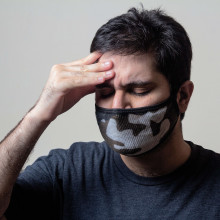
07:36 - COVID virus attacks brain blood vessels
COVID virus attacks brain blood vessels
Markus Schwaninger, University of Lübeck
One of the worrying things about Covid-19 is that in many cases it seems to cause neurological problems such as long term changes to our sense of taste and smell, and so-called “brain fog”. This suggests that the virus is somehow affecting the brain, although we haven’t understood how. Now a new study has shown that the SARS-CoV-2 virus - which causes Covid-19 - can kill the cells - called endothelial cells - that line the small blood vessels that provide the brain with its oxygen supply. Sally Le Page asked the University of Lubeck’s Markus Schwaninger what he thinks is going on...
Markus - They are tiny tubes. They have a diameter of five micrometres so five thousandths of a millimetre in diameter and the wall consists of endothelial cells. These are the cells that form the wall, but outside of the endothelial cell, there is what is called a basement membrane that attaches the endothelial cells with environment.
Sally - So it's a bit like all of these cells are building blocks in the wall and they're all stuck together onto some layer of cement.
Markus - Yes, exactly. What we found is that endothelial cells are lost in SARS-CoV-2 infected patients and only the basement cement as you called it was left over.
Sally - So what happens when the COVID virus infects these cells that are making up the walls of the blood vessels?
Markus - The cell is compromised because the virus production requires energy from the cell. One strategy of the host is that cells that are infected are committing suicide so to speak, to support the survival of the whole organism.
Sally - So if all of the cells that are making up the blood vessels die, what happens to the blood vessel?
Markus - Then there would be no blood flow any longer. That would be lethal, there's no doubt. It's only part of the blood vessels that are dying. In the end, the endothelial cell is gone and only the basement membrane would provide some indication that the blood vessel has been there before. So it's like a ghost vessel that's left over.
Sally - What brains are you looking at when you're looking for this damage?
Markus - We looked at the cortex, the outer part of the brain of patients who died from the disease.
Sally - Now surely it can't be very good for the brain when all of the vessels supplying blood to it get destroyed. What does it mean for the brain as a whole and for the person?
Markus - The blood flow is essential for providing energy and removing waste from the brain tissue. So the effect could lead to stroke-like symptoms for example. If the whole brain is affected it could also lead to confusion, memory loss or delirium in difficult cases.
Sally - Things like confusion and memory loss, they're many of the neurological symptoms people get with long COVID and severe COVID infections. Do you think that it's the virus infecting the blood vessels that is causing these symptoms that we see in COVID patients?
Markus - That's a suggestion that we can make. It could be a cause but we have to do more investigations to prove this concept because so far we just detected these vascular changes. The next thing to investigate would be to link it to the clinical symptoms.
Sally - Obviously you can't investigate the brains of people with long COVID because they still need their brains. Now we know that the virus is damaging the brain, is there anything that we can do to prevent that damage or treat that damage once it's occurred?
Markus - Preventing would be possible if there are small molecule drugs that could inhibit this regulated cell death. However at a later stage, when the damage has occurred, I would assume that it's too late to do anything.
Sally - Have you found drugs that are helpful in preventing this damage?
Markus - Yes, we have tested one drug that prevented the vascular damage in a mouse, but this compound would have to be tested in another species, perhaps also hamsters and then more data is required to see whether the clinical safety is good at all.
Sally - Is it likely that other viruses also damage the brain vessels in a similar way?
Markus - Yes, that's a good suggestion. I mean at least in other coronavirus infections like SARS or MERS, it is very likely that neurological symptoms occurred through a similar mechanism.
Sally - So we might not have this drug in time for the current pandemic but it might be useful in future pandemics.
Markus - Yes, exactly.
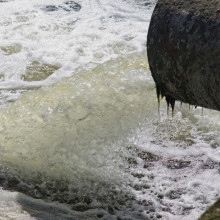
13:20 - Microplastics reveal sewage in UK rivers
Microplastics reveal sewage in UK rivers
Jamie Woodward, University of Manchester
After a recent controversial vote in the UK Parliament and a subsequent government U-turn, the dumping of untreated sewage into rivers by water companies has gained a lot of attention. Sally Le Page spoke with Jamie Woodward from the Department of Geography at the University of Manchester to discuss his latest research, on how tracking microplastics in the riverbed allows us to monitor the dumping of untreated wastewater...
Sally - Jamie, why were you looking for microplastics in our rivers?
Jamie - Well, we decided a few years ago that because most of the research on microplastics is focussed very much on the ocean. So the contamination problem, the oceans, we started thinking about where those microplastics were coming from. So we started looking at UK rivers, particularly rivers in cities where we've got lots of industry and lots of population as a potential source of microplastics into rivers and into the ocean.
Sally - What are these microplastics? Where are they coming from?
Jamie - Well microplastics are pieces of plastic smaller than five millimetres in size but most of the microplastics we find are much smaller than that, smaller than one millimetre. They're mainly coming from wastewater, so we find fibres from commercial and domestic laundry. We find microbeads from industrial processes. We find fragments of plastics from a range of processes from road runoff to industrial processes. They mainly enter the river system through wastewater.
Sally - So every time I wash my synthetic jumper, I'm producing tiny microplastics, but surely that just going to get filtered out when all of that wastewater gets treated?
Jamie - What we've found in our latest work, and this is quite well established in the literature, is that existing wastewater treatments (water treatment plants, sewage treatment plants in the UK and elsewhere) are actually pretty effective at removing microplastics. They can filter out 99% of the microplastics in wastewater if the wastewater is treated properly. We've found lots of microplastics in high concentrations on riverbeds. The only way that microplastics can accumulate on riverbeds is if wastewater is being pumped into rivers at very low flows.
Sally - Oh, I see. So you weren't expecting to see microplastics in there, but it was a sign that the wastewater hadn't been treated properly.
Jamie - When it started we didn't know. We did a survey and found high concentrations of microplastics. What we found is after flood events those microplastics were washed away. So identifying that contamination was a new discovery as well as the process of them being washed away by flooding. The nice thing that comes out of that is that the rivers will clean themselves.Now, ultimately those microplastics will end up in the ocean. Then we started thinking as to how to join up the dots. Well, if floods remove microplastics and water companies are only supposed to put wastewater into rivers during high flows in exceptional rainfall. How on earth are the riverbeds getting contaminated in the first place? So the only way you can get high concentrations of microplastics accumulating on a riverbed is if you're putting untreated wastewater into a river when the river is actually at low flow and you haven't got exceptional rainfall.
Sally - And untreated wastewater, doesn't only contain microplastics, obviously contains faecal bacteria and other horrific things to think about. What harm overall does raw sewage cause to our river ecosystems?
Jamie - Everyone's talking about sewage at the moment, sewage in rivers and sewage in the sea, so basically this is untreated wastewater. It can contain bacteria like e-coli for example, that can make humans seriously ill, but also untreated wastewater can also contain lots of industrial pollutants, toxic chemicals, pharmaceuticals, other bacteria, detergents, pesticides, etc. So there are lots of nasties in untreated wastewater that you don't want in rivers and you don't want them in the ocean.
Sally - Is this happening just in the UK or is it happening in countries worldwide?
Jamie - This is a global problem. So wherever you've got people living in cities in high concentrations producing wastewater and you've got industry as well, you've got a wastewater issue. Where that wastewater is being treated is important. You can reduce the impact obviously on rivers and in the marine environment. There are circumstances when untreated wastewater gets into the river. This is a global problem, but it's become a particular problem in the UK as some of our wastewater systems are quite old. They're Victorian and the infrastructure hasn't been maintained as it should have been. So we get far too many spills of wastewater into rivers.
Sally - Indeed, we've been hearing about it a lot. It's been discussed in the House of Lords and the House of Lords even mentioned your research. That must have been quite validating as a researcher.
Jamie - Yeah, it's nice to do a piece of research that actually influences policy and people are talking about. What we're finding is that the microplastics, when found in high concentrations can be used as an indicator of poor wastewater management. So microplastics themselves can be used as a diagnostic tool to identify when the water companies are not doing what they should be.

18:09 - Is your phone damaging your finger?
Is your phone damaging your finger?
Maxim Horwitz, Chelsea and Westminster Hospital
A viral video spread across the social media platform TikTok last week, in which a girl describes how holding a mobile phone can change the shape and appearance of the little finger. Well established news sources jumped on the story and alluded to the possibility that “smartphone pinky”, as the social media user labelled it, could result in long term permanent damage. And this isn’t the first time it’s been reported. Articles dating to 2016 highlight the phenomenon as well. Here at The Naked Scientists though, we were surprised by the supposedly reliable expertise used in the articles, so we said ‘the gloves are coming off’ and got Harry Lewis to find out from orthopaedic surgeon, Maxim Horwitz, whether we should be changing the way in which we carry our mobiles, or if these claims are just… “phoney”?
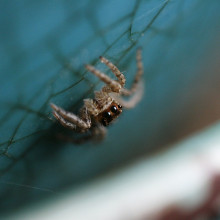
24:09 - What exactly are spiders?
What exactly are spiders?
Sara Goodacre, University of Nottingham
Chris Smith spoke with spider expert Sara Goodacre from the University of Nottingham to get more acquainted with these 8-legged animals...
Sarah - Well, a spider is an eight-legged creature with a head and an abdomen, and it belongs to a family arachnids, which also has the scorpions and a few other strange and wonderful creatures. And they usually make a whole range of different silks.
Chris - Spiders make silk, but scorpions don't. When did they gain this ability?
Sarah - We don't when the ability to make silk actually evolved in the spiders. But we do know they're the only ones that can do it in that family of eight-legged creatures.
Chris - So if we wind the clock back, how far do we have to go back in evolutionary time to find the first spiders?
Sarah - The first spiders arrived quite a long time ago, around 400 million years or thereabouts, and that's well before insects and other things that you might think arose at around the same time, the spiders are much older.
Chris - It's well before the dinosaurs, isn't it? Cause obviously when one thinks about a spider, you almost always think about spiders' webs and them catching insects. So if they actually predate insects, what did they eat?
Sarah - Spiders when they first emerged ate other creepy crawlies, other arthropods. And they mostly trapped those arthropods either in water actually, or on land, so they weren't flying. And they use their silks sometimes to do this, to create sort of trip wires and lines, there are even trapdoor spiders that create a trap door that they hide under. And then they sneak out and quickly grab something walking by. What they didn't do early on was make the big orb webs that insects would fly into.
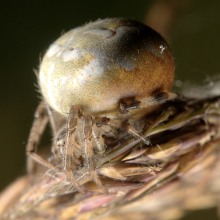
26:13 - Spider Safari: In the Grass
Spider Safari: In the Grass
Brian Eversham, Wildlife Trust
Sally Le Page went to Cambourne to visit Brian Eversham, CEO of the Bedfordshire, Cambridgeshire and Northamptonshire Wildlife Trust, and a massive spider enthusiast. They ventured out into a grassy bit of the nature reserve to go on their very own spider safari.
Brian - So next to the grass here, we've got medium length grass. And what we're looking for are webs between the grasses.
Sally - That is a thick spider, that is a fat body on the other side of that grass.
Brian - And colorful. So from this angle, I can see a bright orange body and pale creamy legs with dark brown bands on them. I'm just going to put my hand underneath there. She's a medium sized, four-spotted Orb-weaver, and she'll be about a centimeter long and fairly heavy. Some of her species are the heaviest British spider. And this is the one with probably the strongest silk of any Orb-weaver. So you definitely walk through a meadow bump into one of these webs and it will for a second actually stop you in your tracks. Ah, yes. So she's moving out to a little shelter. She's tied together several bits of grass to form a little curved, almost a dome, and now she's sitting underneath the dome protected from all sides. And for most angles you can no longer see her. And if I persuade her to drop out of there, we can get a look at her upper side. She's quite a pretty beast. There you go.
Sally - Oh, look at that patterning!
Brian - So, four iridescent pearly white spots, she's ready to start laying eggs. And in the last three or four weeks, she's probably doubled her weight. So she was quite as felt and slender lady until she decides now is the time to reproduce and the body's built for it.
Brian - Shout if you see a big spider!
Sally - Oh, I've got a spider!
Brian - Uh and it's moving! Ah, that's one of the very biggest of the money spiders.
Sally - That's a money spider. That's huge for a money spider.
Brian - Yeah. So what 6, 7, 8 millimeters long and rather pretty. So it's basic background color is dark brown or black, but he's got lovely white zigzags running along the side of the abdomen and probably got striping legs as well. I think that's cute. One reason I can tell it's a money spider, it's sitting on the underside of a sort of hammock web. So the web strung between branches where it's almost horizontal and the spider's resting on the underside of it, basically waiting for insects to fall into it. And at which point it will rush in there and bite them.
Sally - This doesn't have the pretty web you'd expect. It's more like a tangled sheet. Why is that better for the spider than to have your standard orby web?
Brian - I don't think it's a matter of being better, it's a matter of doing something other spiders aren't doing. So most of our money spiders produce the sheet web horizontal to catch things that are falling. Most Orb-weavers spin a vertical web that catch those things flying or bouncing or springing.
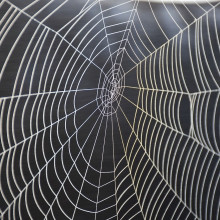
29:14 - Flying spiders and silk antibiotics
Flying spiders and silk antibiotics
Sara Goodacre, University of Nottingham
Chris Smith spoke with University of Nottingham's Sara Goodacre, who studies money spiders and silk evolution to find out more about these high-flying arachnids...
Chris -
Well still with us, of course, is Sarah Goodacre who actually works on money spiders, do you know why they're called that, Sarah?
Sarah -
It's a really good question. So their formal name is the family Linyphiidae. They're also getting quite small, although some of them might be slightly larger and money spiders is the kind of affectionate name that we have for them.
Chris - What do they eat and how do they eat?
Sarah - Money Spiders are really great at eating pests in farmer's fields. They will eat pests in your garden, but the bottom line is they eat a wide range of other invertebrates and occasionally they'll eat each other, too.
Chris - One thing I've noticed about money spiders and not the bigger ones like Sally and Brian found. I didn't even know they could get that big in fact, but usually it's when they go drifting past me on the breeze. Cause you just see this web go by and there's a spider on the end of it. Is, is that an accident? Is that a spider accidentally got detached and it's now on a lifeline as it were, or is this intentional?
Sarah - Well, I think this is one of the behaviors that is so fascinating about spiders. Baby spiderlings of a wide range of other species, they deliberately take to the air. They use their silk as a sail, the climb to high point. It's been a meter or so of silk, which is quite lot, if you're already one or two millimeters long, think about it, and then the wind catches it. And the key thing is once they've made the decision to go up, they've got no control over how far they fly. And we think that some money spiders, so the one that you might've seen drifting past you on a summer's day and they've come from 70 kilometers away.
Chris - Wait, how long? 70?
Sarah - And of course, once they fly 70 kilometers, then once they start fying, they might do so again, the next day and the next day. And we know that some of them could even probably cross oceans. Because when they land on water, they can take off from there as well. And continue that journey.
Chris - How much silk is actually in a spider though, presumably a large amount of the spiders interior is the chemistry that makes silk.
Sarah - Spider silk glands are the most amazing little storage organs where they stole the liquid silk. They absolutely don't want to become solid inside the spider, but once it leaves the spider, we want a fiber to be formed or a glue, because some silks come across as glues. in fact, some spiders spit their silk at each other and spit the sticky glue at each other. Some of the silk that we see is incredibly fine. It's a thousand times finer than a human hair. So actually volume-wise, they've not used as much as you might think to make a really long thread, that's a couple of meters long.
Chris - I did read that people were interested in the medical applications of the silk because obviously it is very biocompatible and therefore it's likely to be well tolerated.
Sarah - So yes, the spider silk is tolerated very well by human cells. Unlike silkworm silk, for example, it really isn't. And because of this, we can actually use those properties to make our own artificial versions. And in my lab, in collaboration with chemists, we've actually added extra molecular twists to the artificial spider silk that we make. In that we've stuck antibiotics onto the silk as well, so that we can make it, as we say, even smarter than the spiders' itself.
Chris - How does that work then? And why, why would you want to stick antibiotics onto the silk?
Sarah - Well, what we think is that the silk might be useful in medical applications. And of course, one of the great challenges of the 21st century is, is microbes bacteria that really can infect wounds and cause all sorts of problems. And the clever thing here is that if we can take some of the properties that we wanted, a spider silk mesh or film, whatever it is we want to produce, and we can add the properties such as anti-microbial antibacterial activity, by sticking an antibiotic on, we can also make it such that the antibiotic only comes off and does its job when there are bacteria active. So we're making materials that are really smart. If you like that really work for what we need in a medical application and yet are inspired by and really built upon the natural world around us. And the inspiration that it's given.
Chris - What sorts of application would one of these antibiotic-laden silks have? Where would you deploy it?
Sarah - So we think that we would use antibiotic silk in something like tissue regrowth or tissue regeneration. One of the key things is you don't just have to stick antibiotics onto it, you can stick growth factors that act as little signals and direction lines for cells to grow along. And so really it's up to the user. What is it you would like your silk to have as an extra function? We know it can be sticky or stretchy. We know it's biodegradable, we know it's see-through, we know it's strong, we know it's fine, etcetera. What else do you want it to have? And if you want it to be antibacterial, if you want it to tell cells how to grow, all of these really are medical applications that we think will just give medics a different set of options for treating whatever condition it is that they're working on. If you think about how diverse the spider family is as a whole, probably there's a whole heap, more inspiration in there, just waiting.
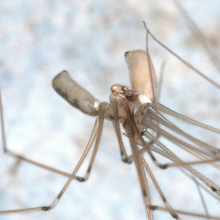
34:06 - Spider Safari: In the House
Spider Safari: In the House
Brian Eversham, Wildlife Trust
Sally Le Page went to Cambourne to visit Brian Eversham, CEO of the Bedfordshire, Cambridgeshire and Northamptonshire Wildlife Trust, and a massive spider enthusiast. They looked inside the Wildlife Trust’s offices at Cambourne to see what spiders live inside with us.
Sally - All right, so we've come inside. If you want to find spiders in your house, where's the best place to look?
Brian - Generally in dark corners and up against the edges of the ceilings.
Sally - Found one. Those are some very long legs.
Brian - Excellent. So that's a big plump female of the long-leg cellar spider. They produce a very loose tangled web along the edges of the ceiling where it joins the wall and her legs are incredibly long. So we're looking at a body less than a centimeter long, but individual legs, probably three or four centimeters and her hunting technique is to hold potentially dangerous prey at arms length, and then dive in very rapidly, stab it with her fangs gifting, injecting a very strong venom and then back off again. And this time of year her major food is probably those poor lost wandering male house spiders.
Sally - She's big in terms of length, but she's quite dainty. Whereas the house spiders are chunky bullies so she can take one of those on?
Brian - Yeah. So their leg span will be twice hers, their body size will probably be 8 or 10 times her body weight, but because she's got the long legs, strong silk, very strong venom, she will catch them, stab them, paralyze them, then wrap them up. And it's not unusual to see two or three males tied up in silk, dangling from the web of a fairly tiny and delicate-looking female cellar spider.
Sally - You say she's got strong venom and I am my fairly certain I have one living in my bedroom. Should I be worried?
Brian - Nope. I've tried very hard and never persuaded want to bite me. Oh, she's doing her thing!
Sally - Oh, oh she's wiggling!
Chris - Yeah. So the cellar spider has this technique of disappearing by spinning around rapidly in a web. So you can't see where her body is. I've just prodded her with a handle. And she's now dangling from the underside of the web spinning around in circles really fast. So she almost vanishes. You can just see the body move in a circle. The legs are no longer visible. And if you were a predator, you wouldn't know where to go.
Sally - And what kind of things are her predators?
Brian - Yeah, mostly cleaners, I would think. A feather dusters perhaps out of doors, then it would be birds and mammals.
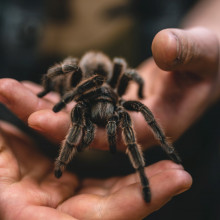
36:37 - How do you get the venom from a spider?
How do you get the venom from a spider?
Samantha Nixon, University of Queensland
We may be safe from deadly spiders here in the UK but that’s certainly not the case in Australia, home to the funnel-web spiders, the most venomous spiders in the world. But it turns out that the same venomous chemicals that can kill us if we get bitten are being developed into life saving drugs. Sally Le Page spoke with Samantha Nixon from the University of Queensland to find out more about venom...
Samantha - It's made of thousands of different molecules. And what's really cool about the spider venom peptides is that they are really, really stable so they can survive heat, they can survive acid. And so these very complex, very stable toxins really give spiders the evolutionary edge to become the most successful terrestrial predators on the planet.
Sally - So we just heard about the cellar spider having particularly nasty venom. What kind of spiders do you work on and how does their venom compare?
Samantha - I'm really interested in tarantulas. And the other spiders that I really focus on in my job are the world's deadliest spiders, the Australian funnel webs. It does this incredibly impressive threat display where it rears up on its back legs, flexing its fangs, and it even drips venom off the tips of its fangs.
Sally - Oh wow. It's not messing around. It's like "I have venom and I'm prepared to use it".
Samantha - It is really telling you like back off, this is not a fight that you want to get into.
Sally - But if it's deadly... a small spider, I mean small compared to a human, it's not going to be eating a human for breakfast. So why does it need such powerful venom?
Samantha - That is such an interesting question. And it turns out to be a really interesting quirk of evolution. They spend most of their lives underground in a burrow where they're quite safe, except that the males have to leave their burrows to go out and find female funnel web spiders. And so while they're out looking for the ladies they're exposed and it turns out that the males have evolved to produce very high amounts of what we call delta hexatoxin or delta atracotoxin. And this is the lethal toxin within the funnel web spiders. And it prevents our nervous system from turning off. So your muscles are constantly spasming and your lungs are trying to breathe, but they end up going into paralysis because there's nervous system overload. This toxin probably evolved just to cause pain, but just because of very slight differences in a human nervous system, it ends up overloading our system so that we can't breathe anymore. And cats and dogs are actually mostly okay when they get bitten by funnel webs because their nervous system is just very slightly different.
Sally - This all sounds horrendous. If I lived in Australia, I would try and stay as far away from funnel-web spiders as possible. But you have them in your lab, am I right to say?
Samantha - Yes. And I totally understand that because I actually was arachnophobic. And I decided to join the research lab to force myself to get over my fear. I manage around about a hundred spiders as well as scorpions and other sort of venomous animals. And I named them all, which helped me to get over my fear. Can't be scared of Beyoncé the tarantula, or...
Sally - Is Beyoncé your favourite?
Samantha - Beyoncé is definitely one of my favourites.
Sally - What is it you're looking at when you're researching this venom?
Samantha - So our lab is broadly interested in how venoms have evolved, what they're made out of and how we can use them to make new medicines and new technologies. So because spider venoms mostly target the nervous system, we do a lot of research into using spider venoms to make new medicines for neurological disorders: things like stroke, chronic pain, epilepsy... Actually by studying a funnel web spider found in Queensland, Australia, my home state, we were able to find one toxin, which actually protects the brain after a stroke and is able to help protect the heart after a heart attack. That toxin is called HI1A. It doesn't stop you from having a stroke or a heart attack, but it helps to slow down all of the death from the lack of oxygen. So we were able to rescue as much as 70% of the stroke size when we administered this peptide in rats, even eight hours after giving them a stroke.
Sally - When you are studying these venoms to work out how you can extract useful chemicals from them, presumably you have to have a vial of venom to look at. So how on earth do you get the venom out of a spider?
Samantha - Very carefully is the short answer. So we call the process milking, and there's a couple of different ways that we go about it. So for the tarantulas, it's a little bit like how you would milk venom from a snake.
Sally - Because we all know how to milk venom from a snake. That's something we all do on a regular basis. I was just milking a snake for its venom last weekend.
Samantha - You know, just normal Friday night kind of activities. I anaesthetise the spider with a little bit of carbon dioxide gas, just makes the spider a little bit sleepier, and I basically will pick the spider up. And then I position the spider over a little sort of test tube with a little bit of plastic over the top. And I, while the spider is still kind of asleep, hold the fangs away from their body and get them to bite down through the plastic. Now, as I said, the spiders don't want to give up their venom if they don't have to. So I give them a very small electric shock to the muscles over their fangs. It doesn't hurt the spider. It's just enough for the muscles to squeeze down and push the venom through the fang into the tube.
Sally - So that's the tarantulas, which I imagine are the easier ones. So what about the huntsman and the funnel webs?
Samantha - The huntsman, I would have to say are the trickiest ones, actually. I have to set up two tiny little pipette tips and then try to put each fang into a pipette tip.
Sally - No stop it, you're making this up.
Samantha - I wish I was making it up, but I have to try to do it quickly because the huntsmans are fast and strong and they do not enjoy this process at all.
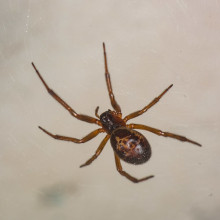
43:16 - Spider Safari: In the Bikeshed
Spider Safari: In the Bikeshed
Brian Eversham, Wildlife Trust
Sally Le Page went to Cambourne to visit Brian Eversham, CEO of the Bedfordshire, Cambridgeshire and Northamptonshire Wildlife Trust, and a massive spider enthusiast. As part of their spider safari, they took a poke around in the bikesheds to see which creatures they could find...
Brian: - So we're here just under the edge of the Wildlife Trust bicycle shelter in the back garden of the Manor House at Cambourne. Ah right, so a medium-sized female house spider, a lovely herringbone pattern down the middle of her back. So dark brown, four markings, about a centimetre long, probably four centimetre leg span when she starts running.
Sally - These are the ones that we see scurrying across the floor? This species, at least?
Brian - That's right. So this I think is a female. So she'll be sitting here waiting for those wandering males to find her. The females remain hidden away, usually webs in corners of rooms or behind bookcases, and the males go hunting for females.
Sally - So it's only the males that you see scurrying across the bathroom floor when you go to the loo in the middle of the night?
Brian - Almost always. And this time of year, they should be adults. So if you've got the patience and the stamina to have a good look at them, then the males have large dangly structures in front of their face, a pair of thing like boxing gloves called palps, and they're what they use both to signal to the female and actually during mating as well. So they can get in quick and mate without giving themselves lunch instead of a partner. Ah, and we have a false widow spider, at last. Huge noble false widow. So this is the big one.
Sally - It's almost red.
Brian - Reddish brown, centimetre long.
Sally - Wow, she's shiny.
Brian - And she's fast. Wow. So that was the noble false widow. Another recent colonist to Britain, been moving north over the last 10, 15 years, globular abdomen, shiny chestnut brown, almost conker-coloured. And usually a pale marking on the top of the back that looks a little bit like a skull if you're so minded to imagine it, and very fast moving when she needs to be, as we just saw.
Sally - So a real black widow, they have a red marking on the back right?
Brian - On the underside, turn them over and you'd see a sort of hourglass shape in red on a dark background, not found in Britain and still a very long way from colonising. So not one to worry about. Today's beast would possibly give me a nip if I tried very hard to hold her and a manipulate her, but as you saw, she's much keener to get out of the way, than waste venom on something that isn't worth eating.
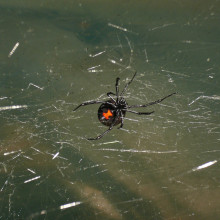
46:05 - Black widow spiders: dating and mating
Black widow spiders: dating and mating
Maydianne Andrade, University of Toronto
We’ve just heard about the false widow spider which has a more famous - or should I say infamous - cousin, the black widow spider. As the name suggests, female black widow spiders don’t tend to be ‘married’ to their partners for very long until death do them part. Chris Smith found out more about the sex lives of these and other spiders is Maydianne Andrade from the University of Toronto:
Maydianne - So spiders mate in a very different way. You just heard that males have structures called palps they're kind of like boxing gloves, essentially the tops of their heads. And those are actually what they use to mate with. And so they would actually climb onto a female in most species and then insert sort of a coil at the top of this boxing glove to transfer sperm. Now, one of the other strange things about it is that there's no direct connection between the place where they make their sperm and these boxing gloves. So they actually have to fill them up before they head off to try to mate with a female.
Chris - When do they become sexually mature? I mean, how long do these spiders live for? And at what point can they begin to reproduce?
Maydianne - So in black widows, the males are actually developed much more quickly and die much more quickly than females, even if they aren't successful at mating and aren't cannibalised. So males might take a couple of months to develop. Females might take three or four months. And so what you end up having is sort of quickly developing relatively small males. They're much smaller than the female. Sometimes several hundred times less in terms of body weight. And the male may only live for a couple of weeks to a couple of months after he becomes sexually mature.
Chris - It seems strange that they should end up being devoured or becoming prey or killed by the very partner they're trying to mate with. Why did that evolve in the first place? It seems counter-intuitive and counter-productive.
Maydianne - So it's counterintuitive to us because we tend to think about collective action towards the same goal, but in terms of most other organisms, males and females are each trying to reproduce successfully. Males are trying to typically have as many offspring as possible, which means mating with multiple females in many species, but for the females, especially for a large, predatory, carnivorous female who can produce more offspring with the more she eats, once she has sperm from a male, she doesn't necessarily need that male anymore. And these species, the male does not help with parental care or anything like that. So for the female, she gets the sperm and then, well, there's a snack available on the web.
Chris - So do they actually store sperm them and just use it when they need it?
Maydianne - Yeah, that's the last part of the puzzle is that female black widows have to store sperm storage organs, and they can actually store sperm for two years after mating only once and continue to produce offspring throughout that time. If they're well fed, we're talking about 100 to 300 offspring every two weeks, for two years after mating,
Chris - Goodness. Can they top up their sperm reserves though? Because if another male comes along and, and happens to be actually a better mating choice, you wouldn't want to put all your eggs in one basket. I mean wrong analogy, but you get what I'm saying. So will the female mate multiple times and therefore have the opportunity to replace what she's already picked up with something that's better genetic stock?
Maydianne - Some females do do that. We don't know kind of their internal rules for that yet. But one of the things we do know about their mating behavior is that if the first male is not a very good quality, say, or does not court her for long enough, she will mate with him or copulate with him only once. And that means only one of her sperm storage organs is filled and the other one is available for any subsequent male who comes along who's actually better quality or invests more in that courtship.
Chris - And how does the female work out whether a male is, is good quality or not?
Maydianne - We know that they can detect a lot about males through the web. So males are vibrating throughout the courtship and they do that by plucking at the web with their palps or those boxing gloves, but also by flexing and extending their legs. So if you imagine a guitar string, it's like the male is plucking at those guitar strings that make up the web as they approach females. That can tell her things about his body size, about his energetic vigour. And then most importantly, we know that that signal is saying, 'I am not prey, I am not prey, I am not prey', at least not until they mate.
Chris - And obviously it's in the male's interest to make sure that he does father as many offspring as possible and pass his genes on to as many new spiders as he can. Is there anything he can do so that he does end up being the father and doesn't get pushed aside by a newcomer?
Maydianne - From the species we've studied, courtship is an endurance competition that really shows the female, 'I am the best father for your offspring'. So we know, for example, in a couple of the species, if the male doesn't court for at least an hour before even touching the female, the female is more likely to kill him before he completely fills up her sperm storage organ. So he will lose out in terms of paternity. In redback spiders, for example, which is an Australian black widow, males can court for up to eight hours before they actually successfully mate with a female. But the males who do that are more likely to mate twice and the females less likely to mate with a rival who shows up later.
Chris - That's some foreplay isn't it? Is there anything else the male can do to avoid being eaten, but nevertheless, manage a successful mating?
Maydianne - The other thing is that these males have actually evolved to mate with females before they become sexually mature, before the female does. So the female just before sexual maturity actually has intact organs underneath her exoskeleton. The male cuts that open and mates through that. And females are much less choosy when they're mated it in that way.

51:43 - QotW: Is dark matter in lumps or like sand?
QotW: Is dark matter in lumps or like sand?
In the classic novella The Little Prince, we encounter our eponymous hero in the middle of the Sahara desert amongst massive sand dunes. He says “What is essential is invisible to the eye”. Just like in the quote, dark matter is an invisible substance that is essential to the makeup and evolution of our universe. To answer Rob’s question, Iacopo Russo asked Durham University professor Francesca Day, and University of Chicago physicist Jacques Pienaar for help...
Fran - Most physicists think Dark Matter exists as individual particles - so much, much smaller than grains of sand. We don't know the size of these Dark Matter particles, but in most theories they would be over a thousand billion billion times lighter than a grain of sand.
Iacopo - We are all familiar with common or normal matter: it’s the stuff that makes up anything around us, like sand, but also rocks, cars and even our bodies. We can see this stuff directly by shining light on it and seeing how it interacts. In contrast, dark matter is stuff that does not interact with light at all. We know it’s there because it explains so much of the way our universe works, but we can’t observe it directly. So why do physicists think dark matter stays as individual particles? I asked Jacques Pienaar, a physicist from the University of Chicago.
Jacques - What current evidence tells us about dark matter is that it interacts very weakly through the electromagnetic force, which is the force that holds objects together in our everyday life. This is also the force holding together smaller objects in space, such as asteroids. But once we move beyond the scale of our everyday interactions, say to the size of planets or stars, the gravitational force becomes the dominant force holding these objects together. The implications for dark matter are that we would not expect lumps in the scale of asteroids or even grains of sand. Dark matter would exist as a cloud of individual particles, which do not interact strongly enough to form clumps.
Iacopo - So, does this mean you cannot make sand castles out of dark matter? Francesca Day has something to say about this.
Fran - This doesn't mean that Dark Matter particles are spread out evenly throughout the universe. Because they do attract each other via gravity. This means that Dark Matter clumps together into dense regions. Galaxies like our own Milky Way form in these denser regions of Dark Matter.
Iacopo - Wait, so: can dark matter form clumps or not? Jacques Pienaar clarifies.
Jacques - What is possible is that when there are large enough clumps of dark matter, i.e. on stellar scales, that the gravitational force becomes strong enough to form very large dark matter objects analogous in some sense to how regular stars are formed out of clouds of hydrogen gas.
Iacopo - Now wouldn’t The Little Prince be happy to learn that this invisible, dark matter was essential to the formation of the very galaxy where we all live in? Next week we are going to run some juicy numbers to answer this question from listener Jodie:
Jodie - Which has the lowest carbon footprint, a punnet of tomatoes from the supermarket or those grown in a grow bag in my garden?










Comments
Add a comment